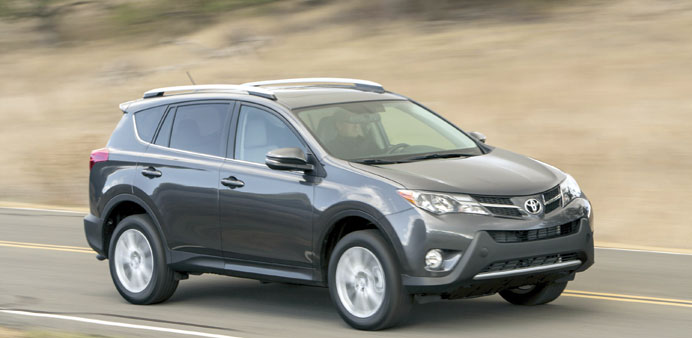By Mark Phelan
Toyota sharpened its focus when it developed the all-new 2013 RAV4 crossover SUV. Gone are the powerful optional V6, outdated four-speed transmission, snug third row of seats and tailgate-mounted spare tyre that made the previous RAV an outlier.
The new five-passenger RAV4 aims for the bull’s-eye in the middle of the crossover SUV market.
Prices start at $23,300 (in the US) for a base front-wheel drive model. All-wheel drive models start at $24,700. All RAV4s have a 176hp 2.5-litre four-cylinder engine and six-speed automatic transmission.
I tested a well-equipped AWD RAV4 XLE. It had a navigation system, voice recognition, Bluetooth phone and audio compatibility and cloth upholstery.
The RAV4 competes with five-seat crossovers such as the Chevrolet Equinox, Ford Escape, Honda CR-V, Hyundai Santa Fe Sport, Kia Sportage, Nissan Rogue, Subaru Forester and Volkswagen Tiguan.
It’s hard to get attention in that crowded segment. The RAV4 makes its pitch with good fuel economy, a roomy interior and excellent voice recognition for phone calls and navigation.
The passenger compartment is 100.7 cu ft with good head, leg and shoulder room. The cargo area offers 38.4 cu ft behind the rear seat and 73.4 with the rear seats folded flat.
The tailgate is hinged at the top, like most SUVs and station wagons. The outside-mounted spare tyre that forced the old RAV to use a side-hinged door has moved inside, under the cargo floor.
The new tailgate is one of the RAV4’s greatest improvements. It’s much easier to use in crowded parking areas.
The interior materials and trim are peculiar. The centre of the dashboard — an area you’re never likely to touch — is covered by a soft, cushioned pad of pseudo-leather.
It’s attractive, but why not put that comfy cover on the door armrests, which are covered with a thin layer of fabric? There’s no place to rest your outboard arm and elbow comfortably on a long drive.
The centre armrest — which is padded — covers a roomy bin. That storage space would be very useful if it housed the USB port and a power outlet for mobile phones. Unfortunately, those utilities reside in the centre stack, below the climate controls. Cords, phones and music players connected to them create clutter.
The gaps between some interior trim pieces were uneven. None is egregious, but Toyota’s designers placed several in the driver’s line of sight, where they drew my gaze like a chipped tooth draws your tongue.
The RAV4 I tested had a 6.1-inch touch screen to control phone, audio, navigation and online services. The screen is smaller and less sensitive than the best that competitors offer.
Toyota’s Entune Internet functions — which include Bing searches for navigation, Pandora Internet radio and more — worked well. It was a marked improvement from the glitchy system in a Toyota Avalon I tested earlier this year. It uses your smartphone’s Internet connection, so there’s no additional cost for data, but Toyota will charge for most Entune functions after three years.
The RAV4 AWD rated 22 mpg in the city, 29 on the highway and 25 combined in EPA tests. Among AWD competitors, the combined rating trails only the new 2014 Subaru Forester 2.5i. It matches Ford Escape’s 1.6-litre EcoBoost and beat the others. The front-drive RAV4 rated 24 mpg in the city, 31 on the highway and 26 combined.
The quick-shifting six-speed automatic transmission teams with the four-cylinder engine to give the RAV4 good acceleration. The steering and suspension lean more toward sporty driving than you might expect from a mainstream Toyota. The RAV4 has little squat or dive under acceleration, but the chassis communicates bumpy surfaces to the passengers.
The brakes are terrific, with communicative pedals and plenty of stopping power. The RAV4’s exterior design features a snub-nosed front, a fast windshield and tidy C-pillars. It’s a pleasant shape that doesn’t draw much attention to itself.
That’s true of most aspects of the 2013 RAV4. It doesn’t demand the spotlight, but good fuel economy and interior space plant it firmly in the mainstream of the crossover SUV market. Detroit Free Press/MCT
(Price and technical specifications may vary in locally available models)
In a nutshell
In a nutshell
Vehicle type: Front- or all-wheel drive five-passenger crossover SUV.
Reasons to buy: Fuel economy, passenger and cargo room, excellent voice recognition.
Shortcomings: Interior materials, minor interior fit issues, operation of some controls.

